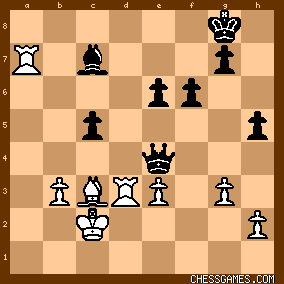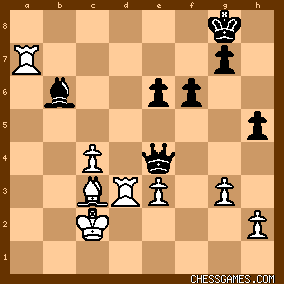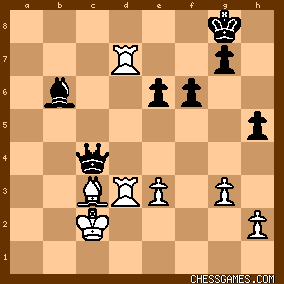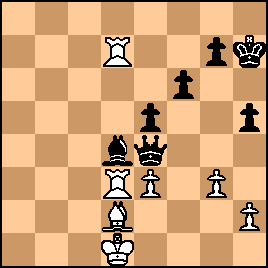|
< Earlier Kibitzing · PAGE 2 OF 2 ·
Later Kibitzing> |
| Aug-05-16 | | weary willy: Oh Penguincw ...if white played 33 Ra8+ in your line, it would make life a lot easier. |
|
Aug-05-16
 | | Penguincw: < weary willy: Oh Penguincw ...if white played 33 Ra8+ in your line, it would make life a lot easier. > Oops, I just realized I missed 33...Qxa8. :p Thanks for pointing that out. |
|
Aug-05-16
 | | al wazir: I got the first two moves before losing the plot. (I wanted to play 33...Bxe3 and then go after the g- and h-♙s with the ♗.) |
|
Aug-05-16
 | | al wazir: White could have lasted longer by keeping his ♔ on the black squares, e.g., with 37. Kf2. If now 37...Bd4, then 38. Rb3, with 39. Rbb7 to follow. |
|
| Aug-05-16 | | devere: 31...c4 32.bxc4 Bb6 is easy to see. What is difficult to see is how strong it is. |
|
| Aug-05-16 | | Once: An unusual puzzle. It doesn't resolve itself in a firework of tactics. Instead we get more of a positional solution, where black frees his game but still has a lot of work to do. I suppose the point is that black has to do something about his threatened bishop but a straight-forward bishop retreat allows black to play Ra4 attacking the white queen. Then black is having way too much fun. Instead 31...c4 creates an immediate attack on the white Rd2 and blocks the fourth rank so that Ra4 doesn't have so much impact. It also shifts the c5 pawn which was making the black bishop mostly bad. Black doesn't mind the temporary pawn sacrifice because his more mobile pieces will sweep up weak white pawns. The other interesting thing about this position is that white would really like to double his rooks on the seventh rank. White makes it difficult for him to do that by using his queen and bishop to attack both white rooks. Black has to settle for doubling on the d file which is far less attractive because there is not much to attack from there. A subtle puzzle. I quite like that. In human mode I "got" the solution but wasn't wholly convinced that it was winning. |
|
| Aug-05-16 | | gofer: Hmmm, I saw the combination of Bb6 and c4 and knew that c4 had to come first, due to Ra4 causing problems.
So we get <31 ... c4 32 bxc4 Bb6> at this point I had no idea where the rook might go; a6, a4, d7 or e7.
All had some merit. So as I wasn't able to choose I wasn't able to progress. I thought the point of Bb6 was
to win Pe3 not Pc4, so really I got nowhere today... ...nil point. |
|
| Aug-05-16 | | gofer: <Penguincw: < weary willy: Oh Penguincw ...if white played 33 Ra8+ in your line, it would make life a lot easier. >
Oops, I just realized I missed 33...Qxa8. :p Thanks for pointing that out.> Don't worry <Penguincw>, <A R Saleh Salem> managed to miss that <16 Qxa8> was a losing move too!!! |
|
| Aug-05-16 | | Cybe: Gofer: Don't worry <Penguincw>, <A R Saleh Salem> managed to miss that <16 Qxa8> was a losing move too!!! 16. Q:a8 is not losing move – this still is a draw. I suppose, that weaked move was 21. e3 (instead of 21. Rfc1). |
|
Aug-05-16
 | | steinitzfan: Looks like a game excerpt rather than a puzzle to me. I have no clue as to what would be required to consider it solved. I looked at sacrificing a bishop for two connected passed pawns (i.e. 31...Bxg3 followed by a queen check at g2 to pick up the other pawn). I don't know if there's sufficient compensation there and I don't think it could be calculated. |
|
Aug-05-16
 | | steinitzfan: On second thought the bishop sac looks bad. 31...Bxg3; 32 hxg3, Qg2+; White moves, Qxg3; 34 Rd8+, Kh7; 35 Bxf6 and I would not be happy in Black's position. |
|
| Aug-05-16 | | YouRang: Friday 31...?

click for larger view
Every so often you solve a puzzle not by finding the clever combination, but by simply asking "what would I play here?". Today was such a case. I tried to find some clever combination that would allow me to attack the pinned Rd3 or fork the stray Ra7, but without success. Finally I just looked at the position and thought that I (black) would have a winning game if I could make passed pawns. When I finally turned my attention to winning pawns, things began to make sense. The main pawn that needs to go is Pe3, and that's easy: <31...c4 32.bxc4> opens the a7-g1 diagonal allowing the <32...Bb6>, forking of Ra7 and Pe3, while also attacking Pc4.

click for larger view
Here, I guessed that white might play <33.Ra4> to guard Pc4, and then <33...Bxe3>, giving me a passed Pe6.

click for larger view
This is just awful for white, he is practically paralyzed and my bishop can now to work on white's h & g pawns. Trying to improve for white, I then considered <33.Rd7> (as played), which frees the king from the defense of Rd3. This leaves me with the choice of taking Pe3 or Pc4. I think grabbing white's passed pawn <33...Qxc4> would be best since it represent's white's best chance to cause me trouble:

click for larger view
It's not clear what white plays now, but I'm satisfied that black is much better. White's isolated e-pawn and distant g & h pawns are poorly defended. With white's K so exposed, the pawns are very targetable with queen forks. Meanwhile, my K is safe and my connected pawns are nearly unassailable after ...e5. |
|
| Aug-05-16 | | stacase: Yeah, how many matching moves into this do you need to claim, "I Got it!"? |
|
| Aug-05-16 | | kevin86: This one was clearly above my pay grade :( |
|
| Aug-05-16 | | agb2002: Black has a queen and a pawn for two rooks.
White threatens 32.Rxc7.
White's weakest point seems to be the pawn on h2. This suggests 31... c4 32.bxc4 Bb6, attempting Bxe3 and Bg1 while keeping an eye on the c-pawn. For example, 33.Ra1 Bxe3 34.Re1 Qg2+ 35.Kd1 Bf2 36.Rd2 Qf3+ 37.Ree2 Qxc3 38.Rxf2 Qxc4. I can't do much more today. |
|
| Aug-05-16 | | dark.horse: 37...Bd4!
Nice move by the bish. |
|
| Aug-05-16 | | drollere: material is about equal, or white is slightly ahead, but the white K is in a more vulnerable position. white's immediate threat is Rxc7. c4 is the obvious way to exploit the rook pin but it is neutralized by the p at b3. c4, pxc4, Qxc4 trades the pin on a R for something less. Qg2+ allows white to rearrange his defenses. i missed that Bb6 takes a tempo away from the white R if played *before* Qxc4. doubling the rooks is clearly a defensive move. my incomprehension includes 33. ... Qxc4, when 33. ... Bxe3 seems useful to prepare Qg2+. i can guess 34. Kd1 means white didn't like the B pin and was worried about Qa2+, but i don't see what is fatal about 40. ... Qe2. i also doubt black foresaw 37. ... Bd4. this game does show how R+B don't play well together ... one always leaves the other one hanging. |
|
| Aug-05-16 | | thegoodanarchist: I got the first 2 moves so I consider that sufficient for a check mark |
|
| Aug-05-16 | | morfishine: I guess its 2 problems: find 31...c4 & 37...Bd4
but there seems to be lots of room for White improvements all along this sequence I give this one a diluted thumbs down
***** |
|
| Aug-05-16 | | drollere: <31...c4 creates an immediate attack on the white Rd2 and blocks the fourth rank so that Ra4 doesn't have so much impact.> yes, i'd call
31. ... c4
32. Ra4 b3+
not having much of an impact ... it loses one R or the other! |
|
| Aug-05-16 | | Patriot: I figured 31...c4 32.bxc4 Bb7 33.Rad7 but thought 33...Bxe3 may be played. I like 33...Qxc4 best though. |
|
| Aug-05-16 | | patzer2: Deep stuff for a Friday puzzle. The solution 31...c4! is a clearance sacrifice targeting the critical White pawn on e3. Black manages to temporarily save the e3 pawn, but only at the cost of giving up the exchange and allowing White to target the remaining King-side pawns. I had the right idea but the wrong strategy with 31...Bb6  . Much stronger is 31...c4! followed by 32...Bb6 . Much stronger is 31...c4! followed by 32...Bb6  . . |
|
| Aug-06-16 | | RandomVisitor: After 15...Qc7

click for larger viewKomodo-10-64bit:
<+0.13/44 16.Nd3 Nc6 17.Rfd1> a5 18.e3 Rad8 19.Kg1 Qc8 20.Rac1 Qa6 21.Rd2 a4 22.Qe2 Rb8 23.Qg4 Rf7 24.Ne1 Qb7 25.Rcd1 Bf8 26.Qe4 Nb4 27.Qxb7 Rxb7 28.a3 Nc6 29.Kg2 d6 30.f4 Rb8 31.Nf3 Ra7 32.Rd3 Kf7 33.Nd2 Na5 34.g4 Be7 35.f5 g6 36.fxe6+ Kxe6 37.Kf3 Raa8 38.h3 Kf7 39.Rd5 Nc6 |
|
| May-07-25 | | goodevans: I really like 37...Bd4!

click for larger viewWhite is forced to sac the exchange. Trying to save the Rd3 loses the other R to a fork. |
|
May-07-25
 | | Teyss: Agree with <goodevans>, neat interference. That was the point of 35...Kh7 first, to avoid the saving move Rd8+, else Black could have done the combination two moves earlier. At this level there is no doubt White saw 16...Nc6 so he basically wanted to exchange the Q for 2 Rs. Why not, some players are more confortable with unbalanced material and analysing the resulting position is above my pay grade. But then he should have activated his Rs instead of doing it 13 moves later. It appeared Black's Q+B were too active and posed threats White needed to deal with first. The pun:
One of the players is Japanese ❌
The game was played in Japan ❌
It is a 7-move miniature ❌
It was played in 1954 ❌
White committed seppuku ❌
Oh I get it, apart form the location the first letters are the same as A R Saleh Salem 's initials. Great movie BTW. |
|
 |
|
< Earlier Kibitzing · PAGE 2 OF 2 ·
Later Kibitzing> |





